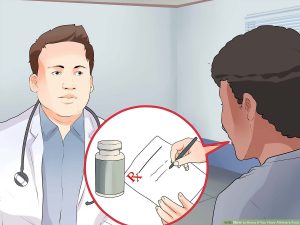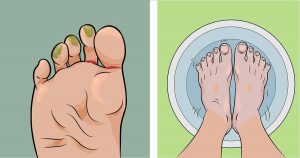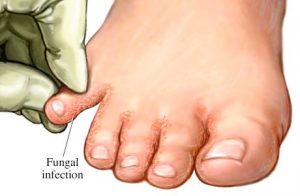What is a Hong Kong foot?
Hong Kong feet, medically called tinea pedis, also commonly known as athlete’s foot, are caused by foot infection with mold (a type of fungus with obvious hyphae). Because Taiwan is located in a subtropical climate, the weather is hot and humid, which happens to be The most suitable growth environment for molds, so athlete’s foot is not uncommon in Taiwan, and it is even a common disease.
What are the symptoms of Hong Kong foot disease?
Common Hong Kong foot symptoms include itching, peeling, and redness of the skin. In severe cases, there may be blisters and foul-smelling exudates between the fingers. The early symptoms are desquamation and cracks between the fingers. If not properly treated, the symptoms may worsen. If the bacterial infection is combined at this time, the blisters may turn into pustules, and even cellulitis may even be infected in the most severe cases.
How did the Hong Kong foot develop?
The types of Hong Kong feet are distinguished by the characteristics of the lesions:
1. Thick skin type: also known as “old Hong Kong feet”, old means being infected with mold for a long time, the body is not likely to have a serious inflammation reaction to this mold, so the patient usually does not feel itchy; however, mold and skin As a result of repeated coexistence, the skin keratin is constantly proliferating, and the mold grows more and more. If the feet are sweating, they will be very smelly when they are stuffed. Therefore, most patients are accompanied by severe foot odor. It is usually caused by Trichophyton rubrum and is one of the most common types.
2. Foot blister type: The other is the inflammatory type of Hong Kong foot. The patient will feel itchy and blisters. In this case, it usually takes less time for Hong Kong foot to be infected.
3. Interdigital erosion type: As a scratch may produce wounds, it may cause cellulitis if you are not careful, even when bacteria on your hands also take the opportunity to enter the human body, it may also evolve from a mold infection to a bacterial infection.

What are the complications of Hong Kong feet?
Cellulitis:
Most of them appear in the acute stage of tinea pedis. If blisters or pustules appear, they need to be handled with care. Do not puncture arbitrarily, and pay attention to cleaning at all times to avoid infection and cellulitis. Serious infections may require amputation or even death.
What are the reasons for the Hong Kong foot?
The main cause of tinea pedis is dermatophytes, including three types of fungi: Microsporum spp., Trichophyton spp., and Epidermophyton floccosum ), common pathogenic species Trichophyton rubrum, Trichophyton mentagrophytes var. mentagrophytes, var. echinacea, var. quinckeanum, Epidermophyton floccosum, etc. Dermatophytes are highly resistant and can survive for months to years in shedding dander or hair. Dermatophytes are mainly transmitted directly through abrasions, but they can also be transmitted indirectly through contact with contaminated utensils, combs, and scissors. In addition, some dermatophytes can also be infected through animal contact and land contact. Dermatophytes like to invade the stratum corneum of the skin, so they often cause thickening or peeling of the skin in patients. Other bacterial species that may cause Hong Kong feet are relatively rare, mainly Candida spp. Occurs in immunocompromised patients, it is a kind of bacteria that already exists in the human epidermis, which infects mainly through wounds and invades mucous membranes.
These people have a high chance of getting Hong Kong feet!
Those infected with mold
There is a tinea pedis patient at home
People with low immunity
How to prevent the occurrence of Hong Kong foot?
Proper foot care can achieve the purpose of preventing tinea pedis:
1. Avoid using public slippers, it is best to bring your slippers.
2. For those who are prone to sweating on the feet, it is recommended to use antiperspirants and prickly heat powder to keep them dry.
3. Wear cotton socks that absorb sweat.
4. Try to wear sandals in summer, and don’t wear the same pair of shoes every day.
5. To wear sports shoes, choose a breathable lattice mesh upper.
6. Leather shoes are best to choose leather and breathable.
7. Avoid contact with the dander of tinea pedis patients.

How to diagnose Hong Kong foot?
Itchy feet are not necessarily a Hong Kong foot, it may also be eczema or sweat herpes. You must see a doctor diagnose it before you can prescribe the right medicine. The symptoms of some sweat herpes are similar to those of the Hong Kong foot. It is necessary to scrape dandruff for microscopic examination and to be more accurate, it requires mold culture to confirm the diagnosis.
How to treat Hong Kong feet?
The treatment of tinea pedis is mainly drug treatment, and the drugs need to be diagnosed before they can be prescribed. Different types of tinea pedis use different drugs. The correct use of ointment is to use both toes, between the toes, the soles of the feet, and the sides of the feet. Apply ointment at the right time and complete the entire course of treatment according to the doctor’s instructions to cure it. Don’t stop taking the medicine just because the affected area is no longer itchy so that the mold has a chance to make a comeback.
Treatment methods for various types of Hong Kong feet:
1. Thick skin type
It is better to exfoliate with salicylic acid or medicine that softens the keratin, and then pair it with anti-fungal medicine. Thick skin type is the most difficult type to treat. Doctors usually take oral antifungal drugs or extend the course of topical drugs.
2. Blisters on the side of the foot, erosion between the fingers
The treatment methods of the two are similar. The use of anti-fungal topical drugs and continuous application for 1 month can significantly improve. At present, there are long-acting drugs that can achieve the effects of traditional drugs as long as one rub.

After getting a Hong Kong foot, how should I take care of it?
Athlete’s foot is a disease that can be cured, but statistics show that about 65 percent of patients relapse more than four times a year. The main reason is that most people have not completed a complete course of treatment. Nearly 90 percent of Hong Kong’s external foot medicines need to be used continuously for at least 4 weeks However, only 13% of the patients did complete the course of treatment. Please be sure to follow the doctor’s instructions to complete the overall course of treatment. Moreover, many people believe that unfounded remedies will aggravate the condition, hurt their pockets and the body.
In addition, the socks that the patient touches should be sterilized by boiling to avoid repeated infections.
Hot blogs:
The Easiest Custom Insoles: Heat Moldable Insoles
Custom insoles, also known as orthotic insoles, are designed to provide personalized support and comfort for individuals with various foot conditions. In [...]
Children’s Insole Size Conversion Chart
The standard sizes for shoe insoles may vary from country to country, making it a headache to choose the right insole for [...]
Do custom orthotics need to be made by a doctor personally?
Custom orthotics do not necessarily need to be made by a doctor personally. While doctors, specifically podiatrists or orthopedic specialists, are often [...]
Do NBA players use custom insoles?
Custom insoles are not only helpful for people with foot health issues, but they also play a significant role in targeting the [...]
